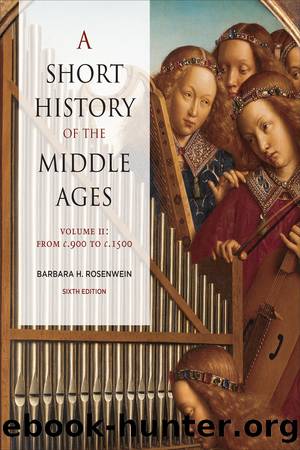A Short History of the Middle Ages, Volume II by Rosenwein Barbara;

Author:Rosenwein, Barbara;
Language: eng
Format: epub
Tags: Middle Ages., Europe – History – 476–1492.
Publisher: University of Toronto Press
Gothic Art and Architecture
Certainly, town and gown agreed on building style: by c.1200, âGothicâ (the term itself comes from the sixteenth century) was their architecture of choice. Beginning as a variant of Romanesque in the Ile-de-France, Gothic quickly took on an identity of its own. It masked the heavy walls of Romanesque churches with sculpture, glass, and soaring vaults. Suger, abbot of Saint-Denis and the promoter of Capetian royal power (see p. 195), was the styleâs first sponsor. When he rebuilt portions of his church around 1135, he tried to express royal and ecclesiastical ideals in material form. At the west end of his church, the point where the faithful entered, Suger decorated the portals with sculptures of Old Testament kings, queens, and patriarchs, signaling the links between the present king and his illustrious predecessors. Reconstructing the interior of the east end of his church as well, Suger used pointed arches and stained glass to let in light, which Suger believed to be Godâs own âillumination,â capable of transporting the worshipper from the âslime of earthâ to the âpurity of Heaven.â
Gothic was an urban architecture, reflecting â in its grand size, jewel-like windows, and bright ornaments â the aspirations, pride, and confidence of rich and powerful merchants, artisans, and churchmen. The Gothic cathedral, which could take centuries to complete, was often the religious, social, and commercial focal point of a city. Funds for these buildings might come from the cityâs bishop himself, from the canons (priests) who served his cathedral, or from townsmen.
Although there never was a âmodelâ Gothic church, Chartres Cathedral may serve as a useful example. In 1194, a fire burned down much of the older church there but spared its most sacred relic, the Virginâs veil. That sign of divine favor inspired the bishop of Chartres and his canons (the priests who served him) to dedicate their enormous wealth in tithes and estates to rebuild. The guilds of the city turned over much of their income to the enterprise. Rich donations poured in from every corner of France. The cathedral rose anew in record time. (For the location of Chartres, see Map 6.4 on p. 217.)
The architects of Chartres put a premium on soaring height, lancet windows, pointed arches, and light, as a comparison of its interior (Plate 6.4 on p. 240) to that of the Romanesque church at Modena (Plate 5.10 on p. 202) makes clear.
Download
This site does not store any files on its server. We only index and link to content provided by other sites. Please contact the content providers to delete copyright contents if any and email us, we'll remove relevant links or contents immediately.
Kathy Andrews Collection by Kathy Andrews(10500)
The remains of the day by Kazuo Ishiguro(7537)
Spare by Prince Harry The Duke of Sussex(4186)
Paper Towns by Green John(4162)
The Body: A Guide for Occupants by Bill Bryson(3786)
Be in a Treehouse by Pete Nelson(3204)
Harry Potter and the Goblet Of Fire by J.K. Rowling(3020)
Goodbye Paradise(2946)
Never by Ken Follett(2865)
Into Thin Air by Jon Krakauer(2691)
The Remains of the Day by Kazuo Ishiguro(2611)
The Genius of Japanese Carpentry by Azby Brown(2598)
The Cellar by Natasha Preston(2590)
Drawing Shortcuts: Developing Quick Drawing Skills Using Today's Technology by Leggitt Jim(2523)
120 Days of Sodom by Marquis de Sade(2425)
Architecture 101 by Nicole Bridge(2347)
The Man Who Died Twice by Richard Osman(2287)
Machine Learning at Scale with H2O by Gregory Keys | David Whiting(2252)
Fairy Tale by Stephen King(2056)
